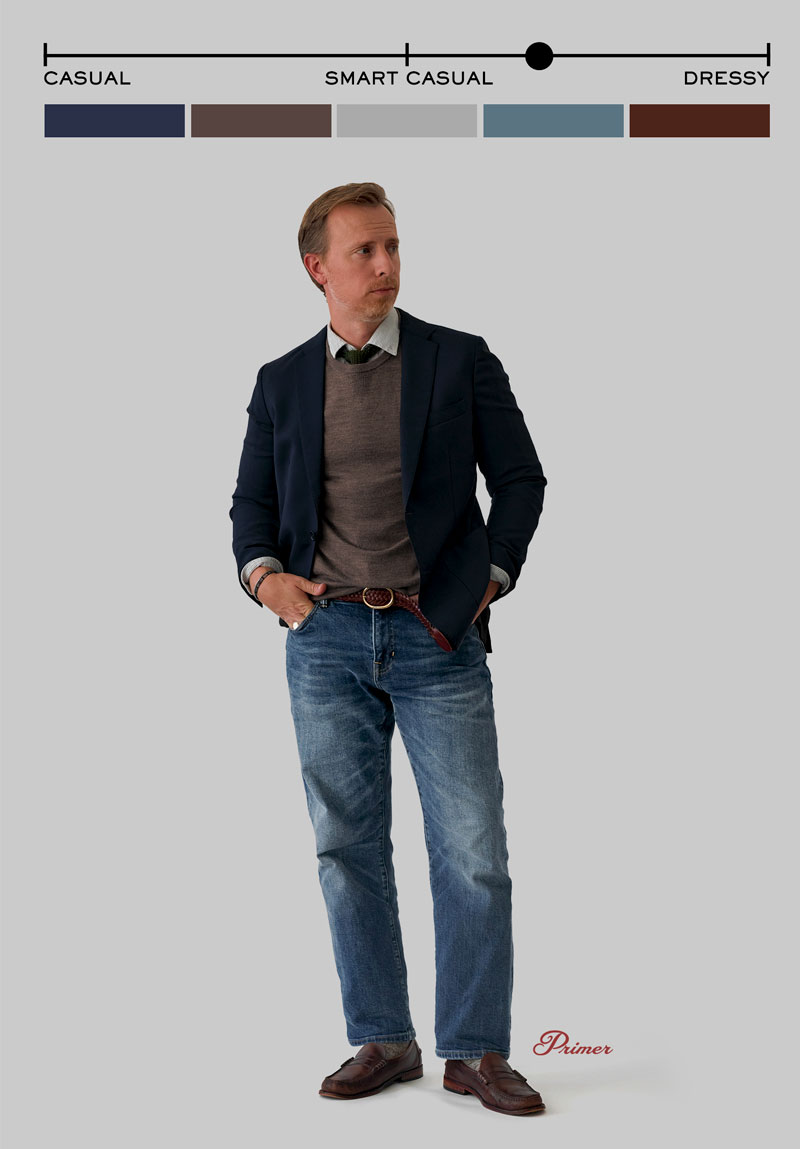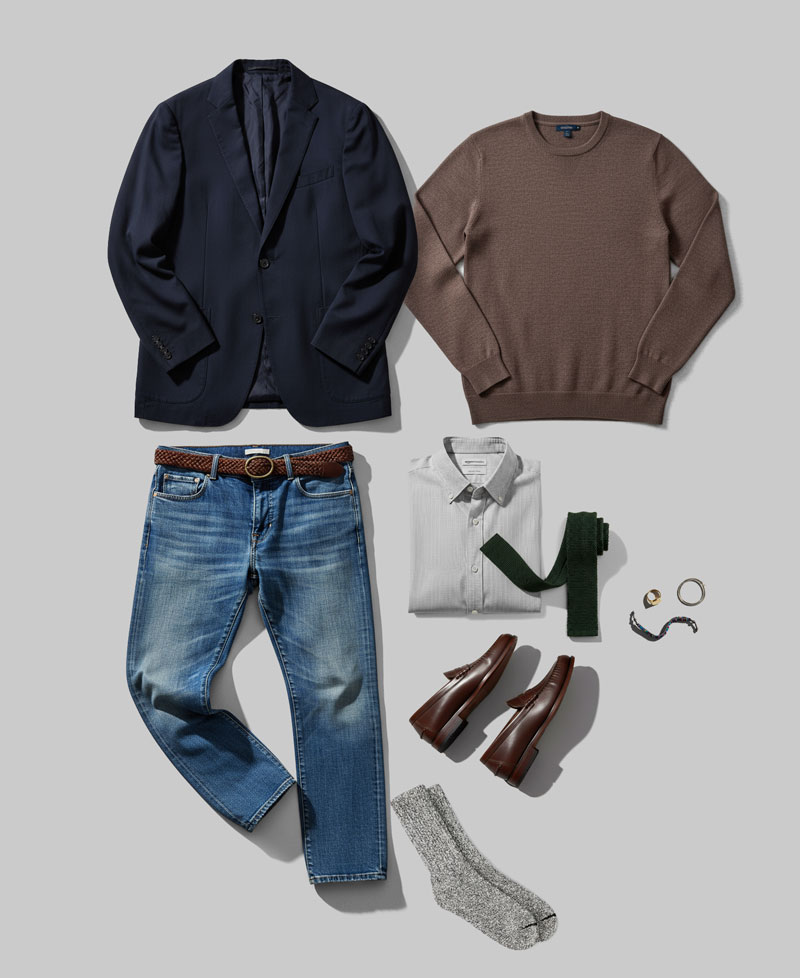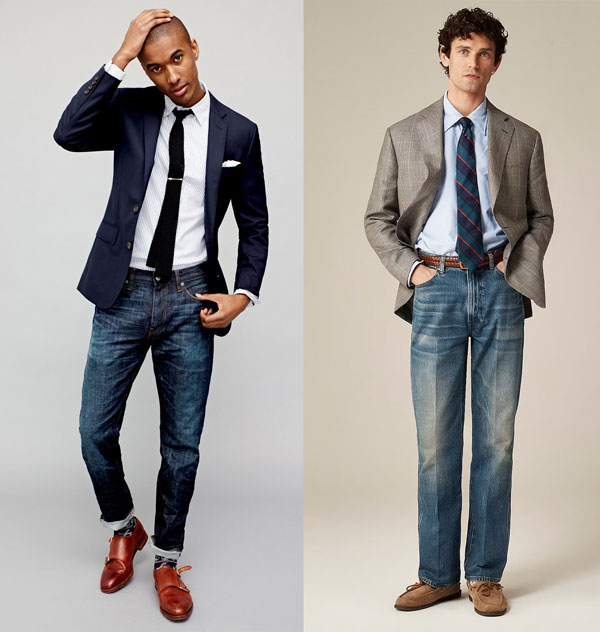A development standing report.
Its an outfit males have worn for many years: navy blazer, denims, loafers.
The format stays the identical, however every decade has formed it into its personal reflection. Within the early Nineteen Nineties, this look was half of a bigger temper, prosperous, collegiate, comfy with itself.
American menswear favored pure shoulders, comfortable tailoring, heavier denim, and a laid-back type of polish. It was the peak of post-Nineteen Eighties optimism and the beginning of what you would possibly name the “Hole-era democracy” when dressing effectively did not imply arduous. The J.Crew catalog bought this look by staging it close to docks and Jeeps, all the time inside strolling distance of both a lacrosse subject or a bookstore.


Get the look:
Blazer: J.Crew / Faherty / Lands Finish
Sweater: Amazon Necessities / Flint & Tinder / Quince
Striped Oxford Shirt: Amazon Necessities
Knit Tie: J.Crew / Amazon
Ragg Socks: J.Crew
Penny Loafers: Florsheim / Banana Republic Manufacturing facility / GH Bass
Jewellery
The inventive route of that period was to look competent and culturally fluent: a person who performed contact soccer at Thanksgiving and helped his cousin transfer on weekends. The looseness of the blazer, the familiarity of the denims, and the tie left barely loosened all signaled a type of common excellence. You wore the outfit as a result of it labored and had labored, and the truth that it regarded a little bit old style was a part of the appeal, not within the costume sense, however in the way in which the items regarded like stuff you’d all the time had.
Just like the pleated chinos you would possibly paint the ceiling in, as one J.Crew cowl in 1993 confirmed. The old style high quality got here from polish that felt lived in. “That is simply what I put on.” That’s why it regarded so informal.
By 2015, that goodwill had tightened.
The tradition had shifted towards optimization: Calorie monitoring, standing desks, private branding. But it surely didn’t occur suddenly.
The silhouettes of the 90s had been unfastened and simple, however they lived in distinct silos; your costume garments had been one factor, your informal garments one other. They didn’t combine. As younger millennial professionals pushed into areas that also required enterprise informal+, the intuition was to hold ahead the dressy silhouette in additional informal supplies: Denims, sweaters, and shirts all acquired slimmer to move. Slimmer meant sharper, and sharper might combine with the leftover tailoring.

A tie was nonetheless worn, however possibly it was skinny now. Denims changed pleated khakis, however needed to be darkish, slim, and sharp. You had been nonetheless assembling the look, however with extra informal elements.
This was the delivery of what emerged as good informal: a costume code method that nodded towards end result versus a particular record of acceptable gadgets like khakis or a tie. A move / fail check for situational appropriateness, and fewer a uniform.
The proportions continued to slender, materials acquired sleeker, and heritage was packaged into exact, curated decisions. The denims had been stiff and darkish, usually uncooked, and deliberately cuffed. The blazer was shorter, the match nearer, the styling stuffed with little strikes like pocket squares however no belt, sprezzatura ties, and monk straps.
Within the early 2000s we nonetheless wore costume socks with loafers however they had to be enjoyable patterns. By the mid 10s, the socks had been gone altogether.
You wore it to show you can nonetheless look dressed whereas dodging the formality of an precise go well with. It co-evolved with open workplace plans and startup tradition, workplaces that traded hierarchy for hoodies however nonetheless anticipated you to seem like you had style.
The J.Crew of this period gave you guidelines: trim your collar, hem your pants, slim your life. It was nonetheless aspirational, however with homework.
Because it all the time does, a brand new technology has entered the workforce responding to what got here earlier than. If millennials had been avoiding the rigidity of enterprise informal by refining their informal clothes, Gen Z has inherited an surroundings the place they reject the necessity to justify what they wish to put on. Looser matches aren’t simply about consolation, the proportions have softened as a result of the posture has too. The rejection isn’t a rejection to the polish, it’s refusing the duty to justify selecting consolation and drape.

Whereas it might seem to be a full aesthetic swing from only a few years in the past, philosophically they’re persevering with what the millennials began earlier than them, and Gen X earlier than them, and the Child Boomers earlier than that. Every technology has reacted to the expectations it inherited. The media usually describes it like a development swing, however actually it’s a pure development.
In 2025, the denims are fuller and lighter wash. The blazer matches, however doesn’t hug the physique. The tie isn’t there to show something. Put on it, do not put on it, it does not matter; extra akin to deciding for those who’ll put on a watch or not.
There’s much less stress between the items. The socks are current with loafers once more. The belt has texture however is neither a costume belt or a thick denims belt. It’s not attempting to decorate down tailoring to make it acceptable. It’s simply… worn.
In 1990, it was refined confidence by calculated nonchalance. In 2015, it was tasteful informal by way of precision. In 2025, it’s steadiness with out justification. None of those variations are higher or worse. They only inform you what the second valued.
And that’s what retains the outfit helpful. The shape doesn’t change a lot, however the method does.

